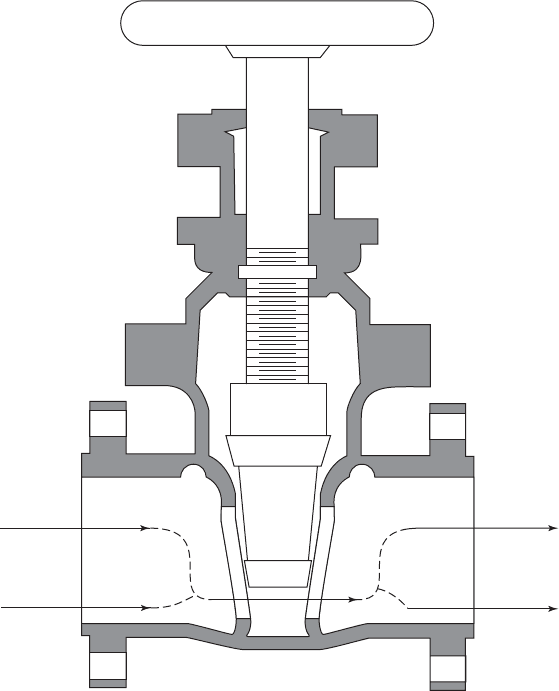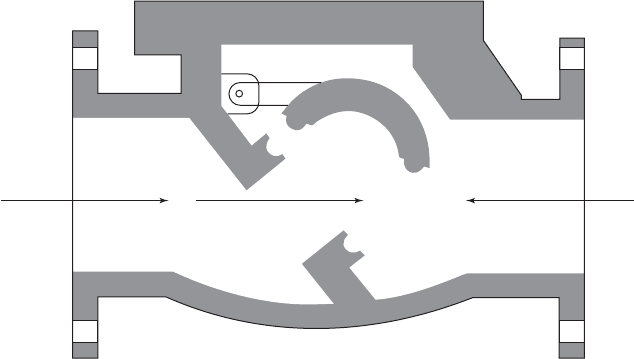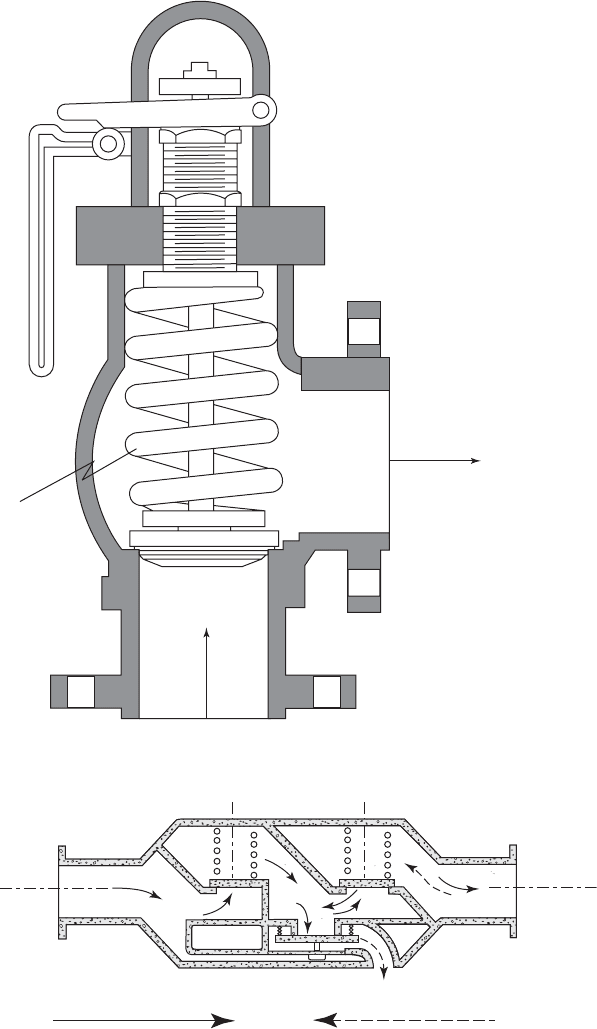Water and Wastewater Engineering
Подождите немного. Документ загружается.


17-10 WATER AND WASTEWATER ENGINEERING
The Uniform Plumbing Code requires that water pressures not exceed 550 kPa at service
connection unless the service is provided with a pressure-reducing valve. Some typical service
pressure criteria are summarized in Table 17-5 .
Hints from the Field
E xperience has shown the following:
• Pressures under 350 kPa will not supply adequate working pressure (150 kPa) at faucets
located at the top floor of a six-story building, and pressures under 200 kPa are unable to
supply the upper floors of a four-story building.
• Booster stations should be located such that the minimum inlet pressure to the pump is
above 240 kPa and preferably above 275 kPa.
17-4 PIPE NETWORK DESIGN
The design of the pipe network in a distribution system is an iterative process based on the de-
sired pressure in the system under different demand conditions. Trial pipe diameters are selected
for the network of pipes, and a hydraulic analysis is performed for the range of conditions. Of the
numerous issues that must be addressed in the network design, the following will be presented in
this section:
• Pipe material selection.
• Pipe diameter and spacing.
• Design equations.
• Simple network evaluation.
• Valve selection and spacing.
• Hydrant spacing.
• Minor loss calculation.
Condition
Service pressure,
kPa
Service pressure,
m of water
Maximum pressure 450–550 46–56
Minimum pressure during maximum day 240 24.5
Minimum pressure during peak hour 170 17.3
Minimum pressure during fires 140 14.3
TABLE 17-5
Typical service pressure criteria
A dapted from Ysusi, 2000.
STORAGE AND DISTRIBUTION SYSTEMS 17-11
Pipe Material Selection
Standards and spec ifications for pipes are available from the American National Standards In-
stitute (ANSI) and the American Water Works Association. These should be obtained for actual
design specifications.
Common pipe materials for water distribution systems are ductile iron pipe (DIP), polyvinyl
chloride (PVC) pipe, high den
sity polyethylene (HDPE) pipe, reinforced concrete pressure pipe
(RCPP), steel pipe, and asbestos-cement pipe (ACP). ACP has not been used in the last 20–30 years
because of health concerns related to asbestos even though research has shown no association
between water delivered by ACP and disease (Ysus
i, 2000). Steel pipe is rarely used for pipelines
smaller than 400 mm. It is widely used in the western United States for transmission pipelines in
sizes larger than 600 mm. RCPP is not commonly used for water distribution and serves as an
alternative material for transmission lines. It has the disadvantage that it is attacked by soft water,
ac
ids, sulfides, sulfates, and chlorides. It may be cracked by water hammer. The more common
pipe materials are DIP, PVC, and HDPE.
Ductile Iron Pipe (DIP). This is the most common water distribution pipe used in the United
States for water mains 400 mm in diameter or smaller. The standard
length is 5.5 m. Sizes range
from 100 to 1,350 mm. Current practice is to use cement mortar lining and an asphaltic outer
coating. DIP manufacturers recommend that the pipe be encased in a loose-fitting flexible poly-
ethylene tube (0.2 mm thick) in corrosive soils. These are commonly known as “baggies
.”
R ubber push-on and mechanical joints are used to connect the pipes. These joints allow for
about 2 to 5 degrees of deflection. Flanged joints are used for fitting and valve connections in
locations where the pipe is not buried. Service connections, known as corporation stops, may be
installed either before or after pipe installation. DIP is
favored because service connections can
be made while the pipe is in service without shutting off the water s upply to other customers.
AWWA Manual M41 (AWWA, 2003) provides detailed information on design criteria for
earth loads, truck loads, railroad crossings, fittings, thrust restraint, and corrosion protection, as
well as procedures for installation.
Polyvinyl Chloride (PVC) Pipe. This is the most common plastic pipe used in the United
States. Although it is manufac tured in sizes up to 900 mm, the commonly used sizes for water
distribution systems are 300 mm and
smaller. It is rated for pressure capacity at 23 C. As the
operating temperature rises above 23 C, the pressure rating decreases. There are two AWWA
specifications for PVC pipes depending on the size. For the 100 to 300 mm sizes, pressure ratings
are in three classes. These ratings include an allowance for hydraulic trans
ients (pressure surges
or waves). The larger sizes are not rated in the same fashion, and they do not provide an allow-
ance for pressure surges.
R ubber gasket bell and spigot type joints are used to connect the pipes. Ductile iron fittings
are used. PVC is corrosion resistant, and no coating or lining is provided.
High-Density Polyethylene
(HDPE). Although it is manufactured in sizes from 100 to 1,200 mm,
this pipe has primarily served as a transmission line. Like PVC, it is rated for pressure capacity at
23 C. It is rated for pressure transients not exceeding two times the nominal pressure class.
Thermal butt-fusion is the
most widely used method for joining HDPE pipe. This procedure
uses portable equipment to hold the pipe or fittings in close alignment, while opposing ends are
faced, cleaned, heated, melted, fused, and cooled. The pipe is normally joined above ground and

17-12 WATER AND WASTEWATER ENGINEERING
then placed in the trench. This method of joining requires a much higher skill level than push
joints. This joint does not allow for deflection. HDPE is not to be joined by solvent cements,
adhesives, or threaded connections.
D uctile iron fittings are used. HDPE is corrosion resistant, and no coating or lining is provided.
Pipe Diameter and Spacing
GLUMRB (2003) specifies that the minimum size of water main that provides fire protection
and serves fire hydrants shall be 150 mm diameter. Larger size mains will be required to allow
withdrawal of the fire flow while maintaining minimu m pressures. In Michigan, the minimum
size for fire protection is 200 mm. The pipe diameter where fire protection is not to be provided
should be a minimum of 75 mm diameter.
The AWWA (1998) provides the more detailed suggestions shown in Table 17-6 .
Within these guidelines and commensurate with the demand estimates, a trial set of pipe
diameters must be selected. One method of making the initial selec tion is
by using a table such
as that shown in Appendix C.
Pipes are normally placed in the right-of-way (ROW) alongside a public road, so the road net
sets the spacing. The pipes should not be placed under the pavement, except in crossings and un-
usual circumstances, because thi
s makes repairs more difficult and expensive. House connections
on the side of the street opposite the pipeline are made by boring under the roadway.
The depth of the pipe in the ground is a fu nction of the climate (it should be placed below
the frost line), soil load, and wheel loading from vehicles. Thes e cons
iderations are beyond the
scope of this text. An extensive treatise on the subject is presented in Buried Pipe Design e dited
by Moser (2001).
Design Equations
The objective of the hydraulic analy sis of the trial set of pipe diameters is to ensure that the
desired pressure and flow rate is achieved at specific locations in the system. The hydraulic
analysis is based on an extended version of the Bernoulli equation. It may be expressed
as:
p v
g
z
p v
g
z h
f
11
2
1
22
2
2
22gg
() ()
(17-3)
AppurtenanceTypical minimum values
Smallest pipes in network 150 mm
Smallest branching pipes (dead ends) 200 mm
Largest spacing of 150 mm grid
a
180 m
Smallest pipes in high-value district 200 mm
Smallest pipes on principal streets in central district 300 mm
Largest spacing of supply mains or feeders 900 m
TABLE 17-6
Typical distribution piping criteria
a
200 mm pipe is used for larger spacing.
A dapted from AWWA, 1998.

STORAGE AND DISTRIBUTION SYSTEMS 17-13
where p
1
, p
2
pressure at points 1 and 2, m of water
v
1
, v
2
velocities at points 1 and 2, m
3
/s
z
1
, z
2
elevations of points 1 and 2, m
h
f
headloss due to friction, m
specific weight of fluid, kN/m
3
g gravitational acceleration 9.81 m/s
2
It is common to express the terms of Equation 17-3 in elevation of equivalent water height so that
p / g, and ( v )
2
/2 g have units of meters.
Energy loses due to friction are taken into account by the headloss term on the right-hand side
of Equation 17-3. The headloss is calculated using the Hazen-Williams equation (Equation 3-5)
reproduced here for convenience:
h
Q
C
L
D
f
10 7
185
487
.
.
.
⎛
⎝
⎞
⎠
⎛
⎝
⎜
⎞
⎠
⎟
(17-4)
where h
f
headloss, m
Q flow rate, m
3
/ s
L equivalent length of pipe, m
C Hazen-Williams coefficient of roughness
D diameter of pipe, m
Velocities are calculated based on the continuity equation:
QvA
(17-5)
where Q flow rate, m
3
/ s
v velocity of flow, m/s
A cross-sectional area of flow, m
2
Mass balance is used to account for flows into and out of junctions.
To verify that the service pressure meets the design criteria, Equation 17-3 is solved for
p
2
/ .
Simple Network Evaluation
At this point in the discussion, a simplified network evalu ation is useful in illustrating the steps
of the pipe network design process.
A small distribution system at a camp has been selected for this illustration ( Figure 17-2 ).
Fire protection is not included. Water is supplied to the syste
m by a well pumping to an elevated
storage tank. Water from the storage tank supplies the pressure to the distribution system. The
peak hour demand at various points in the distribution system and the corresponding elevations
are given in Table 17-7 .

17-14 WATER AND WASTEWATER ENGINEERING
Example 17-4. Perform a hydraulic analysis to determine if the water pressure at Point H of
the pipe network shown in Figure 17-2 meets a design criterion of 207 kPa. Ignore the velocity
headloss and minor losses for this example.
Staff
C → D : 50 mm f
12.2 m
D → E : 50 mm f
12.2 m
E → F : 50 mm f
12.2 m
= Gate valve
F
JI
GH
Office
Dining hall
Bath house
100 mm f 100 mm f
61.0 m30.5 m
E
D
45.7 m
6.1 m
106.7 m
100 mm f
A
Elevated
storage
100 mm f
B
C
Director
12.2 m
Infirmary
FIGURE 17-2
Camp distribution system layout for Example 17-4 .
Point
Peak hour
demand, m
3
/h
Elevation,
of pipe, m
Bottom of
storage tank (A) 50.0 200.0
B 50.0 177.14
C - 177.14
D 10.0 176.53
E 6.00 176.23
F 3.00 175.62
G 40.0 174.74
H25.0 175.04
I15.0 175.04
TABLE 17-7
Peak hour demand and elevations for Example 17-4

STORAGE AND DISTRIBUTION SYSTEMS 17-15
Solution:
a . The hydraulic analysis was performed in a tabular fashion. The resulting table is shown
below. The calculations are explained below the table.
b . The starting point for the run of pipe from A to C is at the bottom of the water tower. The
head available is that just before the water tower becomes empty. This is the lowest head
that will be available. At this starting point (A) the head available is the “Initial” head of
0.00 m shown in colum
n 4 in the row labeled “A to C.”
c. The “Fall” is the elevation difference between A and C. That is 200.0 m 177.14 m
22.86 m, as shown in column 5 in the row labeled “A to C.”
d. There is no “Rise” in elevation between A and C.
e. The “Total” head available is then 0.00 m fall rise 0.00 22.86 m 0.00 m
22.86 m.
f. The “Headloss” is the friction loss per 100 m of pipe. Using the table in Appendix
C,
the loss is estimated as 5.8 m/100 m of pipe. For the 51.8 m run of pipe, the “Total
headloss” is
5 8
100
518 3 00
.
..
m
m
mm
⎛
⎝
⎞
⎠
()
g. The “Head remaining” is the difference between the Total head available and the Total
headloss:
22 86 3 00 19 86.. .mm m
h. Converting the Head remaining in m to kPa,
()( )19 86 9 8067 194 8.. .m kPa/m of water kPa
This is below the design goal of 207 kPa.
Example 17-4 , hydraulic analysis of camp
Note: (m of water) * (9.8067) kPa.
Head available, m Head remaining
Distance Flow, Pipe size, Fall Rise Headloss, Total
From To Metersm
3
/h mm Initial ()() Total m/100 m headloss, mm kPa
AC 51.8 50 100 0.00 22.86 0.00 22.86 5.8 3.00 19.86 194.72
C D 12.2 10 50 19.86 0.61 0.00 20.47 8.6 1.05 19.42 190.41
C G 106.7 40 100 19.86 2.40 0.00 22.26 3.8 4.05 18.20 178.49
GH 30.5 25 100 18.20 0.00 0.30 17.90 1.6 0.49 17.41 170.76

17-16 WATER AND WASTEWATER ENGINEERING
i. The head remaining (19.86 m) at point C becomes the “Initial” head for the next reach of
pipe (C to D and C to G).
j. The water flow around the junction labeled “C” must balance. The flow into the junc-
tion is 50 m
3
/h. The flow to D is 10 m
3
/h, so the flow to G must be 50 m
3
/h 10 m
3
/h
40 m
3
/h.
k. The head remaining at H is shown in the last column in the last row. It is 170.76 kPa.
Comments:
1 . While it might seem appropriate to stop the calculation at the end of the first row and ad-
just the design selections, the computations are continued to point H. This is done to il-
lustrate that further losses in the system up to point H mu
st also be considered. So rather
than stop and readjust at each point, the adjustment is made for the system as a whole.
2. One alternative adjustment would be to raise the bottom tank elevation [(207 kPa
170.76 kPa)/9.8067 3.70 m]. Another would be to select larger diameter pipes. These
alternatives would have to be evaluated based
on cost.
3. The Bernoulli equation is related to the tabular calculation as follows:
ppv
g
z
v
g
zh
f
211
2
1
2
2
2
22
() ()
The pressure at the bottom of the tank is zero so p
1
0. As noted in the assumptions,
the velocity head is ignored so v
1
and v
2
0. There is no rise, so z
2
0. z
1
22.86 m.
h
f
3.00 m. The Bernoulli equation is then
p
2
002286003 00 19 86
...m
4. The calculations were performed on a spreadsheet. This allows for adjustment of one
value, such as the height of the bottom of the storage tank, to see its implications on
other parts of the system. The headloss was obtained from the appendix, but it can easily
be calculated in the spreadsheet.
5. Thi
s system has no loops. This is not common design prac tice. However, the inclusion
of loops requires flow balancing. This process is commonly carried out using a computer
program. It will be discussed in Section 17-7.
Valve Selection
Valves are a significant component of any water distribution sy stem. They are commonly used
for isolating a section of pipeline for maintenance or repairs, controlling the flow rate, releasing
air, and preventing backflow. Two elements are considered in selecting valves for a d istribu-
tion system design. The first is headlo
ss as the water passes through the valve. The second is the
method of controlling the flow. The headloss characteristics are intrinsically related to the method
of control.

STORAGE AND DISTRIBUTION SYSTEMS 17-17
Four basic closure methods are used for flow control (AWWA, 2006):
• A disc or plug moves against or into an opening. Examples are globe and piston valves.
• A flat, cylindrical, or spherical surface slides across an opening. An example is a gate
valve.
• A disc or ellipse rotates ac
ross the diameter of the pipe. Examples are plug, ball, butterfly,
and cone valves.
• A flexible material moves into a flow passage. Examples are diaphragm and pinch valves.
Gate valves ( F igure 17-3 ) are the most c ommonly u sed type of valve for isolating portions
of a distribution system for pipes in the range 15
0 to 400 mm. Resilient seat gate valves are
favored because the resilient material (e.g., vulcanized rubber) seats against the prismatic body
Handle
Water
flow
FIGURE 17-3
Gate valve.

17-18 WATER AND WASTEWATER ENGINEERING
of the valve. There is no pocket at the bottom of the valve to collect grit. They are not suited
for precise flow control because flow red uction is not proportional to travel of the closure disc.
The characteristics and applications of this and other types of valves are given in Manual M44
(AWWA, 2006).
Special Purpose Valves. For specific system applications, special valves are available to m
ake
operation simpler, more efficient, or automatic. These include:
• Check valves. This is a single-direction valve ( Figure 17-4 ) that allows flow in one direc -
tion and stops reverse flow. They cause significant pressure loss and are recommended for
use only where reverse flow operation would be catastrophic. An exa
mple is the discharge
from a pump where flow reversal might damage the pump.
• Air release valves. An air releas e valve is a self-actuated valve that automatically vents
small pockets of air that accumulate at the high point in a water line.
• Alti tude valves. These are frequently globe-type or piston valves that are installed in stor-
age tank inlet-outlet lines. They remain open as the tank is filled. The
y close during normal
flow conditions. They open again when the pressure in the distribution system becomes less
than the static head of the height of water in the tank.
• Pressure relief valves. These are used to protect against excessive pressure in the water line
( Figure 17-5 ).
• Pressure reducing valves. These are used to provide water to a pressure dis
trict or zone of
lower elevation from a district of higher elevation. They are often globe valves sim ilar to
those of altitude valves. By design, they have a very high pressure drop.
• Reduced pressure zone backflow prevention valve. This valve ( Figure 17-6 ) is used to pre-
vent the reversal of flow that might cause contaminated water to flow into the water line.
Normal
flow
Back flow
FIGURE 17-4
Swing-type check valve shown in the open position.

STORAGE AND DISTRIBUTION SYSTEMS 17-19
Pressure relie
f
Spring
FIGURE 17-5
P r e ssure relief valve. When pressure reaches a critical limit, valve opens to release pressure.
Reversed direction of flowNormal direction of flow
FIGURE 17-6
R e duced pressure zone backflow preventer.
( Source: U.S. PHS, 1963.)
